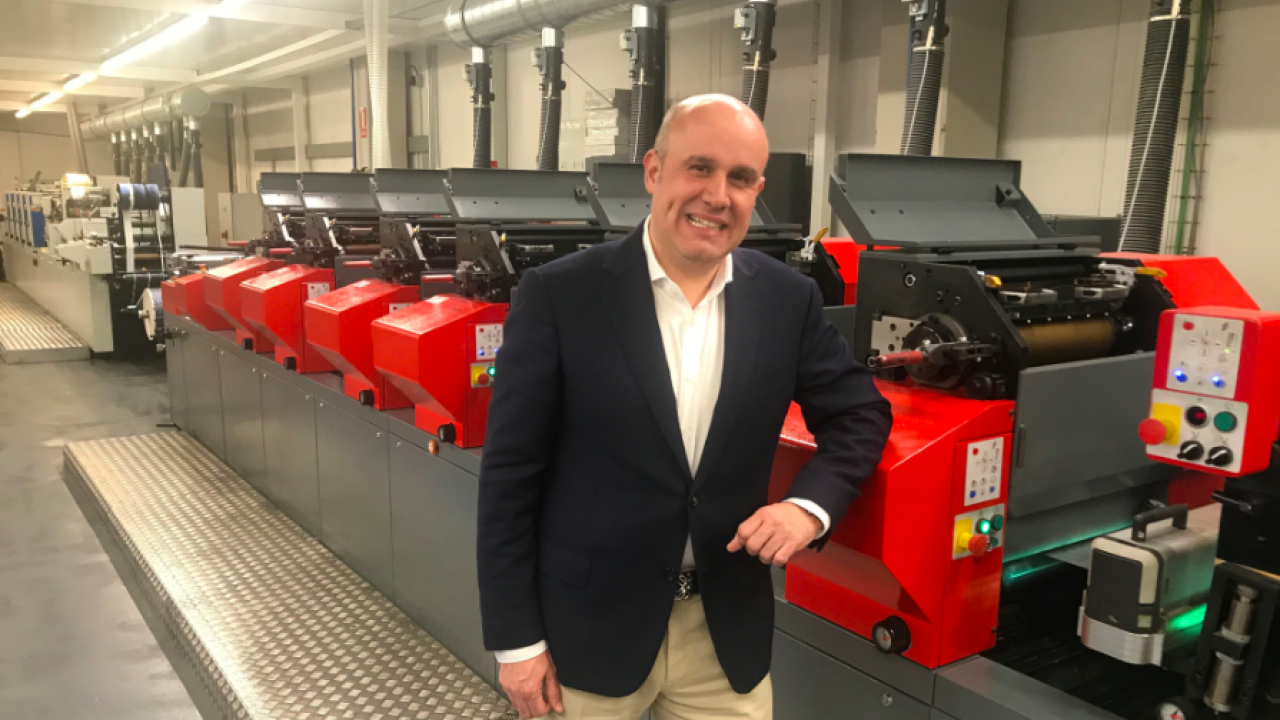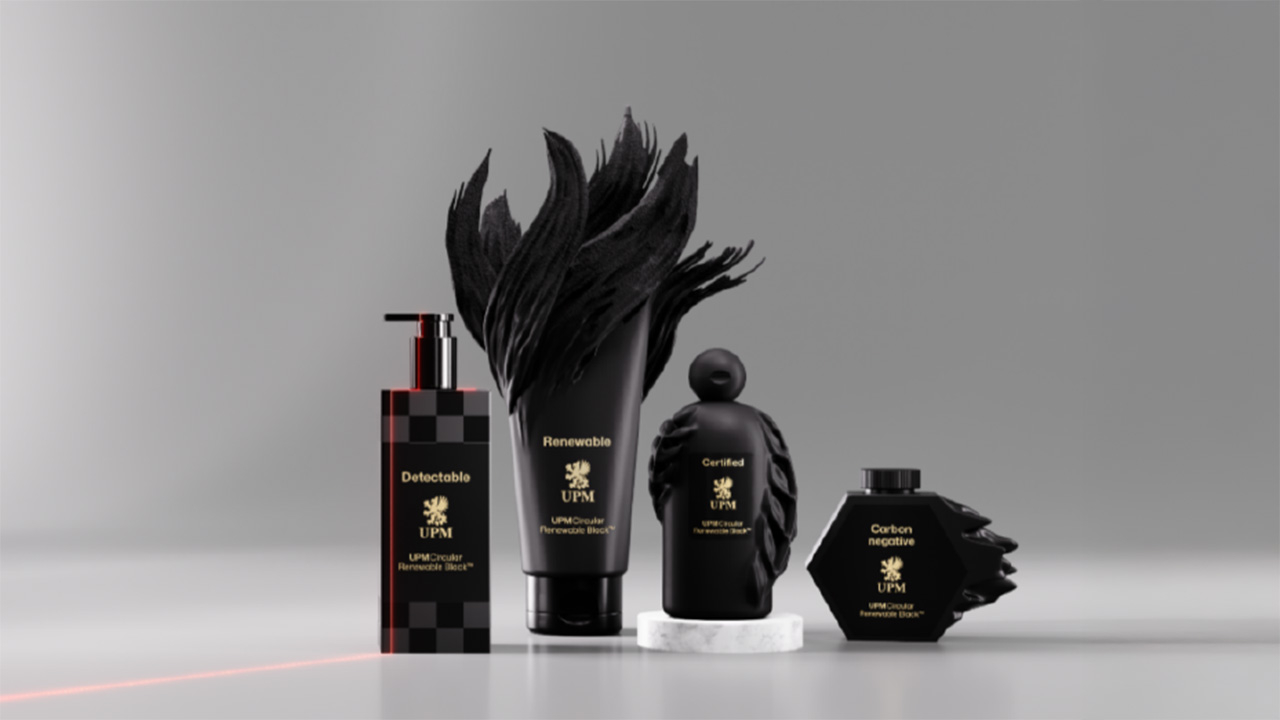Labelgrafic grows presence in Spanish wine label market

Labelgrafic Industrias Gràficas, of Logroño in the Rioja region, boasts a clientele that reads as a roll-call of Spain’s most prestigious wineries – no mean feat for a company that only added roll labels to its sheet-fed capabilities a few years ago.
With a workflow centered on two Codimag presses – one Viva waterless, one Viva Aniflo – plus a strong customer-focused ethic, Labelgrafic has built a reputation for providing innovative branding options, in short and long runs.
With a workforce of 60, Labelgrafic has a varied, 400-strong clientele, ranging from boutique estates to some the most prestigious winemakers in Spain with bottle sales in the millions. Quite a step for a company that, until 2013, had no experience in self-adhesive labeling.
The wine collection at the reception of Labelgrafic’s headquarters gives as good a first impression as any of the company’s credentials and capabilities. The labels are all converted in the recently expanded facilities: metallic strokes evoke the heritage of Muga and Marqués de Murrieta, fine detail delicately depicts the historic Sierra Cantabria estate, while an opaque white lettering of Dmoreno – imposed upon a dark, varnished background – makes all the more impact for its contemporary simplicity.
Sheet-fed, wet-glue labels are still a significant, constant source of business. Produced on a 5-color Heidelberg Speedmaster (see boxout), they are used in diverse markets including water, soft drinks, beer, food, dairy products as well as wine.
Enrique Desamparados, Labelgrafic’s managing director, keenly emphasizes that high-performance technology alone is not enough to succeed, especially in wine markets where the label influences the buying decision, arguably to the greatest extent.
‘The biggest mistake a label converter can make is to come here and just see big numbers on a spreadsheet,’ he says. ‘The leading winemakers come to us because we are dedicated to giving them something special that differentiates their wine in the market. We are prepared to take time developing unique labels, trialing papers, finishing processes and colors, sometimes with the wine producer at the press with us.’
Additional products
By the start of the current decade, members of the Labelgrafic board could see wet-glue declining at the expense of self-adhesive labels. A wider variety of sensually appealing facestocks, varnishes and foiling effects were being introduced. Labelgrafic’s board of directors became convinced of the need to enter the self-adhesive label market as they saw market share of their core wine business fall.
‘Customers were switching to competitors with roll-to-roll technology, which could include more added-value features in one pass, and produce more creative designs, cost-effectively and faster,’ says Desamparados.
‘We recognized that being only a wet-glue label supplier put us at a serious disadvantage, and it was time to adapt – and invest.’
While work began to extend the factory, the management team started researching available technologies. ‘We decided against flexo because we felt it was too risky to switch to a technology we had no experience of. Furthermore, for wine labels there can be no compromise in quality, and in our experience, only offset could meet the demanding expectations of high definition, fine tonal gradation and vividness.’
Labelgrafic’s directors observed the performance of various offset presses at label converters across Europe. Eventually, in 2012, they discovered Codimag. The technical team performed successful printing trials at Codimag’s Bondoufle facility in France. And while other presses could produce quality labels, the Labelgrafic team felt that, in Codimag, they had a machine supplier willing to provide the close ongoing technical assistance, and responsiveness that mirrored their approach to supporting customers. The company specified a 5-color Codimag Viva 340 waterless offset press as its first roll-to-roll press.
‘We approached the investment with trepidation,’ Desamparados reflects. ‘We had no experience in either self-adhesive or with waterless offset. To begin with it was a great challenge, especially getting the tonal ranges correct with new inks, but Codimag provided the training and has always been available to solve technical problems fast.’
Pierre Panel, export sales manager, Codimag, explains: ‘The biggest challenge for a label converter adopting roll-fed technology for the first time is understanding the interactions between processes. For sheet-fed printers like Labelgrafic making this step, we have a specially adapted training program that covers issues like web guidance, tension and rewinding according to customer specifications. We also make a special effort to have them understand the fundamentals of combination printing, and the different processes involved, as most roll-fed presses have in-line finishing while sheet-fed is just offset printing.’
After careful selection of inks and stamping media, Labelgrafic performed trials that soon became contracts. A critical moment in establishing Labelgrafic’s reputation in self-adhesive labels came when it was chosen to reproduce a 130-year-old label design for Marques de Murrieta, one of the region’s most expensive wines. Orders soon came from across Spain and, by 2017, Labelgrafic’s Viva waterless press was at full capacity, working two shifts, five days per week. Struggling to deliver on time, Desamparados realized a second press was essential.
Additional capacity
‘At first we considered a digital press. But while it provided short runs and fast job changes, digital ink costs made it too expensive for longer runs. We were already convinced of Codimag as a reliable partner with knowledgeable staff and fast problemsolving, so naturally we seized the chance to do trials with its new Aniflo printing technology. We were impressed the faster speeds, the ease of operation, as well as the quality. We saw it would fit perfectly with our production plans that included both short and relatively long runs of up to a million labels.’
Aniflo is an intermittent technology combining waterless offset ink and plates with a flexo system for supplying ink to the plate. Ink delivery includes a chamber doctor blade, anilox roll and rubber roller, which in turn delivers ink to the plate and on to the blanket. Each cylinder has the same diameter, ensuring that an exact controllable level of ink is delivered across the web, so exact color is achieved without ghosting. The anilox roll cells are adapted for viscous waterless ink. Ink density is regulated by a temperature control system. A semi-rotary system, Aniflo saves tooling costs because one cylinder can be used for all repeat sizes. It has a shorter web path than fully rotary presses, reducing material waste and manual input.
Labelgrafic’s custom-built 340mm-wide Codimag Viva Aniflo includes six colors with varnishing and foiling. With six colors, Labelgrafic runs two direct colors in addition to CMYK, to achieve any specific customer color request.
Pre-press workflows are fast, taking about half an hour from receipt of the computer file to printing the first label. With stockholding reduced along the supply chain to cut costs, order placement is less predictable. In these circumstances, short set-up times and fast time-to-print are important advantages.
Desamparados says: ‘Five years ago, three-week delivery terms from order placement were the norm. Now, it’s just a week. In that time, you must buy the materials, perhaps reorder die-cutting tools, and have up to a million labels printed and dispatched. That’s why we see ourselves as a service provider – not just a printing company.’
Rioja, like most Spanish wine regions, depends increasingly on export sales, with 108 million liters consumed outside Spain, including fast-growing markets such as Russia and China. Fast make-ready times on the Codimag Viva presses make it possible to change jobs frequently, for example to incorporate language variations, or information to meet national health and safety legislation.
On one occasion, Labelgrafic performed 16 jobs in four hours, totaling 7,600 linear meters, with two substrates and three varnish changes. The simplicity of the plate mounting, which requires no tape and automated register controls ensuring targets are reached with little start-up waste, make this flexibility viable.
The Viva Aniflo has a maximum speed of about 75m/min, making it possible to meet high output requirements at short notice, without excessive material costs. The high speed means Labelgrafic can meet the annual label requirements of CVNE, one of Spain’s largest wineries. For example, design complexity is essential to reflect prestige of CVNE’s many wines. The Cune Rioja Crianza label features five colors, two foil-stamping processes and a flexo varnish. The result achieves the tactile effect and color richness normally associated with screen printing.
‘Codimag’s Viva Aniflo gives us the flexibility of digital, the speed of flexo and the quality of offset,’ continues Desamparados. ‘That means we can maintain uptime when dealing with very short runs and promise short lead times when high output is required, while always being capable of delivering quality with the most challenging designs.’
The label design of La Nieta Viñedos de Páganos for Sierra Cantabria is a reproduction of a 19th century photograph of the winemaker’s historic estate. More than a rebranding to highlight the wine’s heritage, this was also a personal tribute by the present owner to his grandfather, whose role in cultivating the vineyards contributed to the winery’s international standing.
‘The precise registration and smooth tonal ranges achieved on the Codimag Viva Aniflo ensures the faithful representation of the photograph’s finest detail,’ says Desamparados. ‘The owner was thrilled with the result, and for us, it was a chance to show the same care and respect for the production of the label, that is evident in the production of the wine.’
Additional technology
Labelgrafic has kept screen printing as a near-line rather than in-line process, installing a Cartes printing press next to the Codimag machines for tactile effects and thick varnish coverage. An HP Indigo press, also recently installed, provides capacity for very short runs of labels for non-wine sectors, and variable data, applied to wine labels that are then printed on the Codimag presses. This use of digital to complement analog enables Labelgrafic to meet a growing demand for personalized wine bottles, that may include the buyer’s name or a serial number on the label. Attracting high margins, personalized bottles are typically filled from a 250-liter barrel, meaning a production run of approximately 240 labels.
While Labelgrafic was able to adapt to the Aniflo process relatively easily, Codimag and its Iberian agent, Lapeyra y Taltavull, are able to provide technical support and fast supply of consumables. An example is Codimag sourcing tools for creating inside cut-outs on label designs.
‘Rioja’s top designers rely on us to produce the most difficult labels because they know our quality and dedication to achieve perfection,’ says Desamparados. ‘The Codimag presses have put us in an excellent position to achieve the desired creativity.’
Labelgrafic has formed a strategic partnership with another label converter in the region, Gráficas y Adhesivos Ezquerro in Lodosa, Navarra, which has seven flexo presses plus three wet-glue offset presses. While independent, the two companies achieve economies of scale when jointly purchasing materials. Together they offer both sheet and roll label options for all categories – with wine labels taking priority on Codimag presses.
With an in-house sales team and the support of the partner company Ezquerro, Labelgrafic is penetrating wine label markets in Andalusia, Galicia, Portugal and Bordeaux. Admittedly, the French label market is generally more traditional with a reluctance to diverge from protocols for referencing producer, estate, region, appellation and vintage year. Yet a small number of winemakers have seen sharp sales increases after relaunching with quirky, memorable brand names, and labels with innovative graphics and finishing effects. Their distinctive branding achieves better shelf-impact precisely because it breaks convention.
Desamparados concludes: ‘When we installed our first Codimag press, we had no idea of how to print on a roll of paper. We never imagined that in five years, we would become the chosen supplier for some of Spain’s most prestigious wines. Already, our customers are asking when the third press will be installed.’
Stay up to date
Subscribe to the free Label News newsletter and receive the latest content every week. We'll never share your email address.


